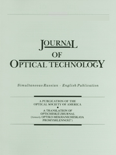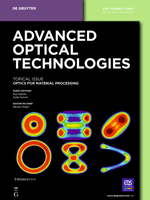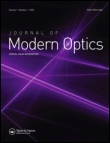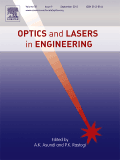
Chinese Optics
Scope & Guideline
Exploring the Depths of Optical Science and Technology.
Introduction
Aims and Scopes
- Optical Imaging and Sensing:
Research focused on developing and enhancing imaging techniques, including optical coherence tomography, hyperspectral imaging, and various microscopy methods for both medical and industrial applications. - Metasurfaces and Optical Materials:
Investigations into the design and application of metasurfaces, including their optical properties and potential uses in photonics and telecommunications. - Optical Communication Technologies:
Studies that advance optical communication systems, including novel modulation techniques, fiber optics, and laser technology for improved data transmission. - Laser Technologies and Applications:
Research related to laser development, including new laser types, laser applications in various fields such as medical, industrial, and scientific research. - Optical Measurement and Calibration Techniques:
Focused on the development of new methods and systems for precise optical measurements, calibration techniques, and error analysis in optical systems. - Quantum Optics and Photonics:
Exploration of quantum phenomena in optics, including quantum imaging, entangled photons, and applications in quantum computing and secure communication. - Advanced Optical Systems and Design:
Research on the design and optimization of complex optical systems, including telescopes, imaging systems, and optical sensors.
Trending and Emerging
- Artificial Intelligence in Optics:
The integration of AI and machine learning techniques into optical systems is gaining momentum, particularly in image processing, analysis, and automation in optical measurements. - Quantum Technologies:
There is a growing focus on quantum optics, including quantum imaging and quantum communication, as researchers seek to harness quantum phenomena for advanced applications. - 3D and Multiscale Imaging Techniques:
Advancements in 3D imaging and reconstruction methods, including photogrammetry and multi-sensor fusion, are emerging as significant areas of interest. - Biomedical Optics and Imaging:
Research related to optical technologies in biomedical applications, including diagnostic imaging and therapeutic techniques, is increasingly prevalent. - Sustainable and Green Photonics:
There is an upward trend in research on environmentally friendly optical materials and devices, focusing on energy-efficient solutions and sustainability in optical technologies. - Nanophotonics and Plasmonics:
The study of light-matter interactions at the nanoscale, particularly the development of plasmonic materials and devices, is expanding rapidly within the journal's scope. - Optical Sensors and IoT Applications:
Emerging research on optical sensors integrated with Internet of Things (IoT) technologies is becoming more prominent, focusing on smart sensing solutions across various industries.
Declining or Waning
- Traditional Optical Components:
Research focusing on conventional optical components such as lenses and prisms has seen a decline, likely due to the increasing interest in novel materials and devices like metasurfaces. - Basic Optical Physics Experiments:
Studies centered on fundamental optical physics experiments are becoming less frequent as the field shifts towards more applied research and technology development. - Static Imaging Techniques:
There is a noticeable reduction in papers discussing static imaging methods, as dynamic and real-time imaging technologies gain more attention due to their practical applications. - Optical Data Storage Technologies:
Research related to traditional optical data storage technologies appears to be declining, possibly due to the rise of alternative data storage methods that utilize electronics over optics. - Optical Coating Technologies:
While still relevant, the publication volume on traditional optical coatings is decreasing, as research focuses more on multifunctional coatings and nanostructured surfaces.
Similar Journals

JOURNAL OF OPTICAL TECHNOLOGY
Illuminating the Future of Optical InnovationJOURNAL OF OPTICAL TECHNOLOGY, published by the Optica Publishing Group, serves as a vital resource for researchers and professionals in the fields of optical technology and related disciplines. Established with a commitment to advancing knowledge, this journal spans a broad spectrum of topics, including applied mathematics, atomic and molecular physics, and various engineering disciplines, with a converged publication period from 1995 to 2024. Although it currently holds a Q4 ranking across multiple categories in 2023, it is an important platform for innovative research ideas in a rapidly evolving field. The absence of Open Access may guide readers to explore alternative access options through institutional subscriptions. The journal’s ISSN is 1070-9762 and its E-ISSN is 1091-0786, ensuring accessibility for a global audience. As a publication aimed at fostering scholarly communication, it invites contributions that highlight emerging trends and novel developments in optical technology, catering to a multifaceted audience of researchers, professionals, and students.

Advanced Optical Technologies
Advancing Knowledge in Optics and PhotonicsAdvanced Optical Technologies is a reputable journal dedicated to advancing the field of optics and photonics, published by FRONTIERS MEDIA SA in Switzerland. Since its inception in 2012, the journal has made significant contributions to the domains of Atomic and Molecular Physics, Electronic, Optical and Magnetic Materials, and Instrumentation, achieving commendable rankings within these categories, including a Q2 quartile classification in 2023. With an emphasis on open access, Advanced Optical Technologies aims to facilitate the rapid dissemination of research findings, thereby fostering collaboration and innovation among researchers, professionals, and students alike. The journal serves as an essential platform for cutting-edge research articles, reviews, and technical notes, and its commitment to quality is reflected in its robust Scopus rankings. As the field of optical technologies continues to expand, this journal plays a crucial role in highlighting pivotal advancements and promoting interdisciplinary dialogue among scholars in the scientific community.

JOURNAL OF MODERN OPTICS
Advancing Knowledge in Atomic and Molecular PhysicsJOURNAL OF MODERN OPTICS, published by Taylor & Francis Ltd, stands as a prominent bi-monthly journal contributing to the fields of Atomic and Molecular Physics and Optics. With an ISSN of 0950-0340 and an E-ISSN of 1362-3044, this journal aims to disseminate high-quality research that pushes the boundaries of optical science and its applications. Since its inception in 1981, and particularly throughout its publications from 1987 to 2024, the journal has consistently published influential studies that are essential for both academic researchers and industry professionals. Ranked in the Q3 quartile for the 2023 category of Atomic and Molecular Physics and Optics, it has a Scopus ranking of #133 out of 224, indicating its steady presence and relevance in the scientific community. Although it does not offer Open Access options, readers can access its rich repository of literature that delves into innovative optical methods, technological advancements, and theoretical frameworks. The JOURNAL OF MODERN OPTICS is an indispensable resource for those seeking to advance their knowledge and research in modern optical science.

Korean Journal of Optics and Photonics
Advancing Innovations in Optics and PhotonicsKorean Journal of Optics and Photonics is a premier publication dedicated to advancing knowledge in the rapidly evolving fields of optics and photonics. Published by the esteemed Optical Society of Korea, this journal serves as a vital platform for researchers, professionals, and students seeking to disseminate their findings and innovations in areas such as optical engineering, photonics technologies, and application developments. Although the journal does not operate under an Open Access model, it is committed to high-quality peer-reviewed research that contributes significantly to both theoretical and practical advancements in the field. With an increasing focus on interdisciplinary research, the Korean Journal of Optics and Photonics is poised to play a crucial role in fostering collaboration and driving the global conversation on light science and technology. The journal's ISSN is 1225-6285 and it also carries the E-ISSN 2287-321X, ensuring its availability to a wide readership.

OPTICS AND LASERS IN ENGINEERING
Connecting Ideas in Optics and Laser EngineeringOPTICS AND LASERS IN ENGINEERING, published by Elsevier Science Ltd, is a premier journal dedicated to advancing the field of optics and laser technology in engineering applications. With a robust ISSN of 0143-8166 and E-ISSN 1873-0302, this journal is positioned within the top quartile (Q1) across several categories, including Atomic and Molecular Physics, Electrical Engineering, and Mechanical Engineering as of 2023, showcasing its prestige and impact in the scientific community. The journal has consistently ranked high in Scopus, notably within the top 10% for Mechanical Engineering and Electronic, Optical, and Magnetic Materials research. Since its inception in 1980, OPTICS AND LASERS IN ENGINEERING has served as a vital platform for disseminating cutting-edge research, fostering innovation and collaboration among researchers, professionals, and academia. Though it does not currently offer Open Access options, its high impact factor and selective publication process ensure that articles reach a wide audience while maintaining rigorous academic standards. Researchers and students alike are encouraged to engage with this influential journal to contribute to and stay abreast of advancements in optical technologies and their engineering applications.

Journal of the European Optical Society-Rapid Publications
Pioneering Quick Communication in Optical SciencesJournal of the European Optical Society-Rapid Publications, with ISSN 1990-2573 and published by EDP Sciences S A, is a premier open access journal dedicated to advancing the field of optics and photonics since its inception in 2006. Based in France, this journal serves as a vibrant platform for researchers, professionals, and students to disseminate their findings quickly and efficiently. Achieving a commendable Q3 ranking in Atomic and Molecular Physics and Optics (2023), it reflects a growing impact within the scientific community, despite currently holding a 33rd percentile rank among similar publications in the realm of Physics and Astronomy. The journal fosters an environment of rapid communication and collaboration, making it an invaluable resource for those interested in the latest developments and innovations in optical sciences. With open access ensuring broad visibility for all published work, the Journal of the European Optical Society-Rapid Publications is positioned as a key contributor to enhancing the understanding and application of optical technologies.

Acta Photonica Sinica
Shaping the Dialogue in Photonics and OpticsActa Photonica Sinica is a peer-reviewed academic journal published by SCIENCE PRESS, focusing on the fields of atomic and molecular physics and optics. Since its inception in 1997, this journal has provided a crucial platform for researchers and professionals to share cutting-edge findings and advancements in photonics and related areas. Despite its current positioning in the Q4 quartile for both atomic and molecular physics and optics, Acta Photonica Sinica remains a significant contributor to the scholarly community, fostering innovative discussions and collaborations. The journal does not currently offer open access, providing a selective but impactful repository of knowledge for readers in China and beyond. As the scientific landscape evolves, the journal aims to enhance its scope and impact, addressing the challenges and opportunities within the photonics domain. Researchers, students, and professionals interested in the latest theoretical and experimental studies will find a wealth of information that emphasizes the pivotal role of optics in scientific and technological advancements.

Nonlinear Optics Quantum Optics-Concepts in Modern Optics
Advancing Knowledge in Nonlinear and Quantum OpticsNonlinear Optics Quantum Optics-Concepts in Modern Optics is a specialized journal published by OLD CITY PUBLISHING INC, focusing on the forefront of research in nonlinear optics and quantum optics. With an ISSN of 1543-0537 and an E-ISSN of 1944-8325, this journal serves as a pivotal platform for the dissemination of innovative concepts and findings in modern optics, significant for both theoretical exploration and practical applications. Established in 2003, the journal's scope encompasses critical areas such as atomic and molecular physics, optical materials, and instrumentation, attracting submissions from a diverse range of interdisciplinary fields. While the journal currently maintains a Q4 ranking in several categories, it continues to strive for higher visibility and impact in the academic community. Researchers and students alike will find valuable insights and contributions that foster advancements in optical science and engineering. With an emphasis on rigorous peer-review, Nonlinear Optics Quantum Optics-Concepts in Modern Optics is committed to enhancing the understanding and application of nonlinear optical phenomena in various technological domains.

OPTICAL AND QUANTUM ELECTRONICS
Charting New Territories in Photonics and ElectronicsOPTICAL AND QUANTUM ELECTRONICS, published by SPRINGER, is a premier journal dedicated to advancing the fields of atomic and molecular physics, optics, and electronic engineering. With an ISSN of 0306-8919 and an E-ISSN of 1572-817X, this journal has established itself as a vital resource for researchers, professionals, and students alike, contributing to the discourse from its inception in 1969 to its continued publications through 2024. It holds impressive rankings in Scopus, placing within the top percentiles for its categories, specifically in the 64th for Electrical and Electronic Engineering and 63rd for Atomic and Molecular Physics. Though it does not currently offer open access options, the journal's robust impact factor reflects its importance within its field, making it an essential reference point for cutting-edge research and developments in materials science and optics. Through its rigorous peer-review process, OPTICAL AND QUANTUM ELECTRONICS remains committed to publishing high-quality, influential studies that push the boundaries of innovation and understanding in these dynamic areas of science.

ACTA OPTICA SINICA
Driving Innovation in Photonics ResearchACTA OPTICA SINICA is a distinguished journal dedicated to the field of optics and photonics, published by the Chinese Laser Press. With an ISSN of 0253-2239, this journal has been an essential resource since its inception, covering significant discoveries and advancements in atomic and molecular physics, electronic materials, and optical sciences. The journal is indexed in Scopus, achieving respectable ranks as Q3 in both Atomic and Molecular Physics, and Optics and Electronic, Optical and Magnetic Materials, reflecting its engagement with current research trends. Although it is not an open-access journal, ACTA OPTICA SINICA is hosted from Shanghai, China, and continues to serve as a vital platform for researchers, professionals, and students alike to disseminate and access high-quality peer-reviewed articles, ensuring its prominent place in the academic discourse related to optics and material sciences.